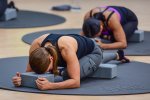
What is Restorative Exercise and Just How Important is it?
There’s no argument over the importance of exercise and the many ways that our bodies benefit from physical activity. We do sometimes, however, overlook the fact that rest and recovery are just as essential in our routines. We all train a little differently and at different levels, but if we’re challenging our bodies and pushing ourselves in our fitness routines, we are also taxing our bodies and causing breakdowns. Our muscles need proper time to rest and to repair so that we perform at our best and feel our best both physically and mentally.
I know, you’ve heard all this before! We all have, but that doesn’t change the fact that many times fitness minded individuals still feel the need to go hard daily while looking at rest and recovery days as a “waste” of valuable workout time. We sometimes ignore the signs of overtraining, or we blame the symptoms on anything and everything besides our fitness routine. Exercise is good for us so how could that be the reason we’re feeling less than wonderful, right?
So, how do you know when you need more rest and recovery? Maybe you’re feeling fatigued or crankier than normal. Maybe you’re a little more anxious or depressed. Maybe you’re having trouble sleeping. Maybe your workouts aren’t feeling as successful, or you have aches and pains in areas throughout the body. There are many little signs. Signals from our body that it needs some additional self-care. The best way we can help our physical, mental, and emotional well-being is by making proper rest and recovery a part of our routines regularly, so that the symptoms of overtraining can’t get their grip on us.
Pictured here are Cathe and Jai performing an assisted pigeon pose in the new Restorative Yoga bonus workout. They are using two yoga blocks, one under the forehead and a second under the glute so that their body weight has some extra support and can easily melt into the position.
This extra support from the blocks enables them to take full advantage of the stretch and stress release. This short restorative routine focuses on stillness and holding long gentle poses to relax the body and the mind. The yoga blocks assist in supporting us through the poses so that our focus can remain on calming the mind and body while releasing tension. This bonus is only one of many routines throughout the new Lift, Move & Restore series that will show us how important both active and restorative recovery is to our overall well-being.
Learn more or pre-order here: https://bit.ly/4bO6lHn




